#Amazon Selling Partner api Developer
Explore tagged Tumblr posts
Text
In the ever-evolving landscape of e-commerce, businesses must stay agile and adapt to technological advancements. One such pivotal shift is the migration from Amazon's Marketplace Web Service (MWS) to the more modern and efficient Selling Partner API (SP-API).
#MWS to Amazon SP-API#Amazon Selling Partner API#mws to sp api migration steps#Hire Amazon SP-API Developers
0 notes
Text
How Much Does It Cost to Develop an eCommerce Mobile App

By 2027, the total annual revenue of the eCommerce industry will reach a staggering USD 5.56 trillion. To put that into perspective, it is more than the GDP of the UK. And that will grow as more people prefer to buy products and services online.
This has encouraged small and large businesses to actively participate in doing more commerce business. We know this because we have worked on many eCommerce app development projects. One of the most common questions is about the eCommerce mobile app development cost.
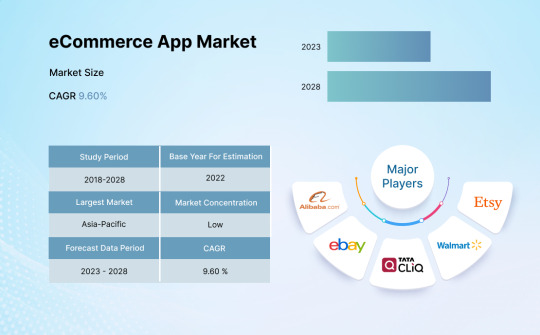
‘How much is it to develop an eCommerce mobile app?’
We will answer it in this post and a few essential factors you need to know about before hiring eCommerce app developers.
Factors That Influence eCommerce App Costs
Let’s look at the factors that decide the cost of eCommerce app development in 2023.
How complex the app is
Developing an eCommerce app like Amazon or Flipkart is a massive task as it involves extensive work and development. And the app is highly complex due to a variety of features.
A few of the elements that make the app complex are:
User account creation.
Payment gateways.
Product catalogues.
The check-out process.
Rewards systems.
EMI payment options.
The more complex the app is, the more expensive the development process is. If you are a small business looking to sell your products, that will cost you less.
Platforms the app is being developed for
If you want to develop the app natively for iOS and Android, that will cost you a lot. It will take a lot of time, and you also need to hire different production teams to work on different app iterations.
This is also going to cost you more money.
The best way to avoid such issues is to do the required market research and create an app that caters to your target audience.
Using a cross-platform app development approach is also highly recommended.
Integration and use of third-party APIs
Creating features natively for your app can increase the overall cost of development, as a developer needs to spend time on it. And that will take more time and money out of your pocket.
Instead, you can integrate third-party APIs to bring all the capabilities and functionalities to your site.
Since they already have working features, you don’t need to worry about their performance.
Whether you want maintenance
Other factors to consider when building an eCommerce app are regular updates and maintenance. You can enter an AMC contract with the eCommerce development company you are working with if needed.
That’s going to cost you extra. However, you can also do that if you want to have an AMC outside of the existing contract.
Either way, maintenance is a crucial element of any app. And the more complex the app is, the more it will cost you.
Customization and design requirements
Suppose you want a highly customized eCommerce mobile app with an impeccably unique design that will take time and cost you more. Developing customized apps right from the ground up is a time-intensive process.
Opting for that will save the time needed to complete the project, which naturally makes the app cost more.
The same thing happens with the design, too. You may use templates or themes available with a few edits. And that brings the cost down.
Where your development partner is located
If you hire eCommerce app developers in the US or the UK, that’s going to cost a lot of money because they charge higher. On the other hand, choosing a partner from India or the Philippines can cost you a lot less money.
There are several reasons for this, and the biggest reason is that labour in India and the Philippines is more affordable.
Hence, you get impressive value for every dollar you invest in the project. And you can get all these without compromising on the quality.
The app development process
Yes, that’s right. Depending on the development process, the cost can vary.
Let’s say you are developing a new eCommerce app right from scratch. It takes time to be ideated, planned, and executed meticulously.
This takes a lot of time.
Instead of that, you can build a clone of an existing app.
And that will cost a lot less as the idea is already there. You must clone the app to fit your products and brand preferences.
Payment gateways
Payment gateways are essential for accepting online payments. But they will cost a lot as integrating them takes time and effort.
Depending on your business, these options change, such as:
Hosting payment gateway as needed into the app.
Integrating the API.
Setting up alternative payments.
Effectively embed the payment gateways into the app.
Integrating mobile wallets as per your needs.
The Cost of Developing eCommerce Apps
We hope you understand the factors affecting the cost of developing an eCommerce app. This is how we explain the cost to our clients. We educate our clients when they want to know about the project's cost.
Here is a table with the approximate amount for developing an eCommerce app.
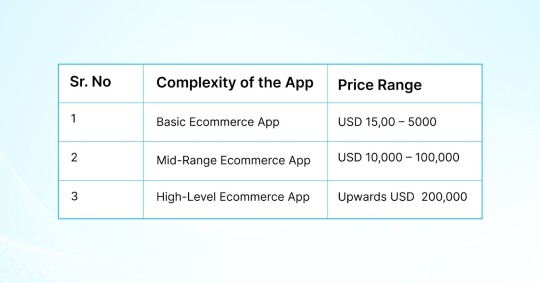
Benefits of Having an eCommerce App for Your Business
While developing an eCommerce app is a considerable investment, it has the potential to take your business to the next level.
Here are a few advantages of using ecommerce apps.
Ease of use
It enables your users to buy products and services more conveniently. They can buy your products anywhere—while travelling, from their office, or at home.
And that can make your business more user-friendly, improving your sales.
Customer experience
Having an ecommerce app improves the overall customer experience. The convenience they can enjoy is unparalleled. And this will positively influence your business.
Brand awareness
People will use it more when your business has an excellent eCommerce app. And they will talk about it in their community, friend circles, etc. This is great for your business as it can expand your brand awareness.
A competitive edge
You can trump your competition with a high-performing and intuitive mobile app to sell your products. As you offer a more convenient way, you can also attract users from your competition
Improved sales
Selling products and services at the store and from your eCommerce app leads to more sales. And you can also reach more people than you could not previously.
How to Develop an eCommerce App on a Budget?
An intelligent approach and expert eCommerce app development company like AddWeb Solution can help you build an eCommerce app on a budget.
Here is what you can do.
Step 1
Don’t release the app with all the features at first. Develop only the most important factors first and add more features later if your users need them.
Step 2
Shopify, WooCommerce, etc., offer many pre-built eCommerce platforms. Use this to save time and money.
Step 3
You must work with an agency that can offer you affordable services. AddWeb Solution in India is an excellent option to do that.
Step 4
Instead of using proprietary software programs, develop the app using open-source platforms and technologies. Some of the open-source technologies are even better than their paid counterparts.
Step 5
You can also reuse the code from your previous app. If you can use some parts of the code, it would reduce the overall development cost for sure.
Step 6
Many eCommerce app development companies offer multiple engagement options. Opt for a fixed-price agreement option, which ensures more value for your project and reduces costs.
Related Article: VueStorefront Headless Commerce A Modern Solution for eCommerce Challenges
Why Choose Us for eCommerce App Development?
When hiring eCommerce app developers, you must hire a reliable eCommerce mobile app design and development company like us.
And if you are wondering why AddWeb Solution is unique, here are a few reasons.
Our expertise in the industry
AddWeb Solution is among the most respected agencies offering eCommerce app development services. We have earned that image by working on diverse projects from large and small businesses during the last decade.
This expertise enables us to work on diverse eCommerce app projects innovatively and deliver the best service at all times.
Trained and skilled developers
You can hire eCommerce app developers confidently from AddWeb Solution. They have the experience and qualifications to do what they are doing. Our practice is to train each of our developers in the latest technologies and frameworks as they are released.
So, you never have to worry about the talent working on your project when you choose AddWeb Solution's eCommerce app development services.
Streamlined development process
Imagine if you have not planned your app development. The result is a waste of resources in terms of money, time, talent, etc. But that does not happen at AddWeb Solution.
We plan every single project we undertake, eCommerce app development or not.
This helps us deliver the project on time, ensure value to the client's investment, and make it easier for them to quickly take their product to the market.
Advanced eCommerce apps
We believe in creating apps that help your business grow. And technology plays a massive role in that. Having realized this, our team of expert eCommerce app developers always leverage the latest technologies to make your app.
This empowers your app with all the features and advanced functionalities you need to impress your existing and prospective customers.
Multiple QA processes
Quality means the world to us as an eCommerce development company in India. We have multiple quality assessment processes and tests to keep the apps we develop at the highest echelon of quality.
Regardless of your industry, your app will always comply with industry standards and often exceed the benchmarks of global quality expectations. Son, you don't need to worry about the quality of our apps.
Conclusion
eCommerce apps help sell your products and services and reach more users easily. Most people worldwide use a smartphone, so you can make your app available to them to encourage them to buy from you. This is a marketing strategy that many businesses have used and has proven highly effective. However, when developing an eCommerce mobile app for your business, you must hire eCommerce app developers who can deliver value and quality. And that’s something we can offer you aplenty.
We have served numerous businesses looking to expand their reach and sales through dedicated eCommerce mobile apps. We have always served tailored eCommerce development services that exceeded their expectations.
Source: How Much Does It Cost to Develop an eCommerce Mobile App
2 notes
·
View notes
Text
Elevate Your Sales with Lexmetech Systems’ Advanced eCommerce Development Solutions

In today’s digital-first world, having a powerful eCommerce platform is no longer optional—it’s a necessity. Whether you're a startup or an established enterprise, your online store must be fast, secure, and user-friendly to drive conversions. That’s where Lexmetech Systems steps in.
Our cutting-edge eCommerce development solutions are designed to transform your digital storefront into a high-performing sales engine. From seamless checkout experiences to AI-powered product recommendations, we help businesses boost revenue, enhance customer engagement, and outshine competitors.
Why Your Business Needs a Next-Gen eCommerce Platform
1. Mobile-First, Responsive Design
Over 60% of online shoppers use mobile devices. If your store isn’t optimized for smartphones, you’re losing sales. Lexmetech builds fully responsive eCommerce websites that deliver a flawless shopping experience across all devices.
2. Lightning-Fast Load Speeds
A 1-second delay in page load time can reduce conversions by 7%. Our developers optimize performance with advanced caching, CDN integration, and streamlined code to ensure your store loads in a blink.
3. Secure & Scalable Infrastructure
Cyber threats are rising, and customers demand security. We implement SSL encryption, PCI compliance, and robust payment gateways to protect transactions. Plus, our solutions scale effortlessly as your business grows.
4. AI & Personalization
Shoppers love tailored experiences. With AI-driven product recommendations, dynamic pricing, and personalized marketing, we help you increase average order value (AOV) and customer retention.
5. Seamless Third-Party Integrations
From ERP and CRM systems to payment processors and logistics, we integrate your store with essential tools for smooth operations and automation.
Lexmetech’s eCommerce Development Expertise
We don’t just build stores—we craft high-converting digital experiences. Our services include:
✅ Custom eCommerce Development – Tailored solutions for unique business needs. ✅ Shopify, WooCommerce, Magento, & BigCommerce – Expertise in leading platforms. ✅ Progressive Web Apps (PWAs) – App-like experiences without app store downloads. ✅ Headless Commerce – Ultra-fast, API-driven storefronts for maximum flexibility. ✅ Omnichannel Selling – Sync your store with Amazon, eBay, and social commerce.
Success Story: How We Helped a Fashion Brand Increase Revenue by 200%
One of our clients, a mid-sized fashion retailer, struggled with slow load times and cart abandonment. After migrating to our custom Magento solution, their:
Page speed improved by 70%
Conversion rate jumped by 35%
Revenue grew by 200% in 6 months
Ready to Supercharge Your Online Sales?
Don’t let a mediocre eCommerce store hold you back. Partner with Lexmetech Systems today and unlock a faster, smarter, and more profitable online business.
🚀 Get Your Free Consultation Now! Contact Us Today https://lexmetech.com/contact
Lexmetech Systems – Where Innovation Meets Results. 🚀
#eCommerceDevelopment#OnlineSalesBoost#LexmetechSystems#TechSolutions#DigitalTransformation#WebDevelopment#ShopifyExperts#MagentoDevelopment#BusinessGrowth#TechInnovation
0 notes
Text
The Future of e-Commerce: How API Integration is Revolutionizing Online Retail
The e-commerce landscape is evolving rapidly, and businesses must adopt advanced technology to stay ahead. One of the most impactful innovations in recent years is e-Commerce API integration. APIs (Application Programming Interfaces) allow seamless communication between different platforms, enabling businesses to automate operations, enhance customer experiences, and scale efficiently. As a result, leading e-Commerce solutions companies are increasingly focusing on API-driven solutions to help businesses streamline their workflows.
Why API Integration is Essential for e-Commerce Growth
E-commerce businesses rely on multiple tools to manage their operations—payment gateways, order fulfillment systems, inventory tracking, and marketing automation platforms. Without integration, managing these processes can become chaotic and inefficient. This is where e-Commerce API integration comes in, offering a seamless way to connect various platforms and eliminate manual work.
One of the most critical applications of API integration is product management API, which helps businesses keep their product catalogs up to date across multiple sales channels. This ensures customers always see accurate stock levels, product descriptions, and pricing, improving the overall shopping experience.
Key Benefits of e-Commerce API Integration
1. Faster and More Accurate Product Updates
A product management API allows businesses to instantly update product information across websites, marketplaces, and social media platforms. Instead of manually adjusting prices or descriptions on each platform, API integration ensures all updates are synchronized in real-time.
2. Automated Order Processing and Fulfillment
Customers expect fast and reliable order fulfillment. API integration connects e-commerce stores directly with warehouses and shipping partners, ensuring that once an order is placed, it is processed automatically. This reduces human errors, minimizes delays, and improves efficiency.
3. Improved Customer Experience
Consumers today demand real-time updates on their orders. e-Commerce API integration enables automated tracking updates, personalized recommendations, and smooth returns, leading to higher customer satisfaction and loyalty.
4. Seamless Multi-Platform Selling
Selling on multiple platforms like Amazon, Shopify, and eBay can be complex. A product management API allows businesses to maintain consistent product listings, stock availability, and pricing across all channels without extra manual effort.
5. Better Decision-Making with Data Insights
APIs enable businesses to gather real-time data from different sources, providing valuable insights into sales performance, customer behavior, and inventory trends. This data helps in making informed decisions, optimizing marketing strategies, and improving overall business performance.
How e-Commerce Solutions Companies Help Businesses Scale
While API integration is powerful, implementing it effectively requires technical expertise. Leading e-Commerce solutions companies offer custom API integration services tailored to specific business needs. These companies provide:
Custom API development: Creating tailored solutions for unique business requirements.
Integration with third-party tools: Connecting e-commerce platforms with CRM, ERP, and analytics systems.
Ongoing support and optimization: Ensuring APIs function smoothly as business needs evolve.
Conclusion
The future of e-commerce lies in seamless automation, and e-Commerce API integration is the key to unlocking efficiency and growth. With the right product management API, businesses can manage inventory effortlessly, enhance customer satisfaction, and scale across multiple channels. By partnering with experienced e-Commerce solutions companies, brands can harness the power of APIs to streamline their operations and drive long-term success.
0 notes
Text
BrainBox AI Introduces the ARIA Virtual Assistant

The first virtual building helper, known as ARIA (Artificial Responsive Intelligent helper), was introduced today by building technology pioneer BrainBox AI. ARIA, which integrates smoothly into daily building management procedures, is meant to improve building efficiency. It is powered by the most recent generative AI technology with Amazon Bedrock. Like Iron Man and Jarvis, ARIA is a unique combination of technology and creativity that makes it the go-to partner for facilities managers. Specifically designed for usage in commercial and retail settings, ARIA has the predictive capacity to avoid issues with operations while keeping an eye on a building’s blind spots, hence revolutionising conventional facilities management.
Using the cutting-edge autonomous AI technology from BrainBox AI as its internal compass, ARIA offers a comprehensive 360-degree view of a building’s data, focusing on its systems and components to generate recommendations for strategic decision-making that are not only accurate but also comprehensively informed. A two-way exchange is fundamental to the architecture of ARIA. In addition to giving it instructions to do certain duties, building operators and facility managers can also rely on the virtual assistant to make decisions and provide direct advice on how to operate their building in the most effective and efficient way going forward.
Customers may easily transition their conversations from desktop to mobile without missing a beat by using ARIA to “call” others via text or voice. The round-the-clock generative AI engine of ARIA assists customers in organising and optimising their buildings. Building management becomes proactive instead of reactive with this master feature, which also raises the building’s value and directly supports an organization’s sustainability initiatives.
“Their customers can reach their specific objectives for decarbonisation, energy consumption, and operational efficiency with the aid of ARIA’s intelligence and intuition, which utilises AI in really novel ways. Cofounder and chief technology officer of BrainBox AI Jean-Simon Venne remarked, “Building teams can focus on more value-driven tasks by assigning mundane operational tasks and repetitive analytics to ARIA.””Generative AI has shown its unlimited potential in every industry in two years. It is a valuable tool to any company looking to remain ahead of the curve in efficiency and innovation, as shown by its quick acceptance by the market and fast expansion.
The totally autonomous feature of the organisation is based on Amazon Bedrock and is encircled by a special blend of AWS Lambda, AWS Fargate, and Amazon Athena services. A wide range of tools enabling BrainBox AI to create generative AI applications with security, privacy, and responsible AI are provided by Amazon Bedrock, a fully managed service that provides a selection of top-performing foundation models from top AI businesses and Amazon via a single API.
BrainBox AI can use machine learning and artificial intelligence (AI) to accelerate innovation and create readily scalable AI-powered products thanks to Amazon Web Services (AWS). BrainBox AI made an official announcement in January announcing its entry into the AWS Partner Network, an international network of AWS partners that pool resources, knowledge, and programmes to develop, promote, and sell client services.
According to Howard Wright, vice president and global head of startups at AWS, “Amazon Bedrock was designed to help companies build transformative generative AI solutions and get to market faster.” “They are thrilled to see ARIA realized a groundbreaking solution that will transform building operations and empower facility managers worldwide to improve energy consumption and decrease emissions. emissions even more than they have been able to do with BrainBox AI’s current solution.”
As it continues to set the standard for built environment solutions, ARIA is BrainBox AI’s lasting imprint on the generative AI field. By lowering HVAC energy expenditures by up to 25% and greenhouse gas emissions by up to 40%, ARIA significantly improves building operations management when combined with BrainBox AI’s core AI for HVAC technology. This major invention that significantly advances the company’s goal of using AI to help preserve the world excites it.
Regarding BrainBox AI BrainBox AI was created in 2017 to address the built environment’s biggest issues carbon emissions and energy usage. BrainBox AI, a decarbonisation pioneer, leverages AI in its innovative HVAC technology to make buildings smarter, greener, and more efficient. BrainBox AI provides real estate customers in a variety of industries with enhanced services, including office buildings, hotels, grocery shops, airports, and more, via strategic worldwide collaborations.
Its workforce of over 170 individuals, with its headquarters located in Montreal, Canada, a worldwide centre for AI, brings talent from various sectors of the business world together with the shared goal of healing the planet. Research partners of BrainBox AI include the Institute for Data Valorization (IVADO), MILA Quebec AI Institute, and academic organisations like McGill University.
FAQS What are the benefits of ARIA? Improved Efficiency: ARIA can help facility managers optimise building operations, reducing energy costs by 25%. ARIA can reduce greenhouse gas emissions by 40% by optimising energy use. Proactive Management: ARIA analyses data and suggests solutions before issues arise, improving building management.
How does ARIA work? Generative AI: ARIA uses generative AI to get new data insights to improve building operations. Data Analysis: ARIA analyses building system and component data to optimise energy usage. Communication: ARIA can advise and answer facility managers.
Read more on Govindhtech.com
0 notes
Text
Unveiling the Next Amazon: Exploring the Features from The Clone Of Amazon

Amazon has dominated as the premier ecommerce marketplace by providing customers and businesses with a smooth, user-friendly platform to buy and sell goods online. When conceptualizing an "Amazon clone" that can compete on its level or even surpass the giant, you must build upon existing features while disrupting with new capabilities.
In the ever-evolving landscape of e-commerce, a new player is making waves by emulating the unparalleled success of Amazon. This groundbreaking venture, often hailed as the "Clone of Amazon," promises a revolutionary shopping experience. Let's delve into the distinctive features that set this platform apart and position it as the potential successor to the e-commerce giant.
What Are the Features Includes - Clone of Amazon

Creating a clone of Amazon involves a meticulous integration of features that closely align with the successful elements of the e-commerce giant. Here are key features typically included in a comprehensive Amazon clone script:
Product Search and Discovery: Emulate Amazon's search capabilities, enabling customers to find products through keywords, filters, and well-organized categories. Implement machine learning algorithms to recommend relevant products based on search history and past orders, ensuring a personalized shopping experience.
Product Listings: Facilitate sellers in creating detailed product listings, encompassing titles, descriptions, images, pricing, variations, and availability details. Generate rich and indexed product schema markup for each listing, optimizing visibility and search engine performance.
Shopping Cart and Checkout: Provide a seamless shopping cart experience, allowing users to effortlessly add or remove products, apply discounts, and proceed to a user-friendly checkout process. Gather necessary contact and shipping details, support various payment methods, and offer options for both guest and user accounts.
Order Management: Implement a robust order management system that tracks the purchase behavior of all users for analytical insights. Offer sellers a unified interface to efficiently manage their orders through email notifications or API integrations with shipping partners. Automate fulfillment processes with integrated warehouse tools.
Administration Portal: Develop a comprehensive dashboard for administrators to manage site content, configure the product catalog, oversee product categories, monitor seller accounts, and access high-level analytics for sales, traffic, and more.
Inventory Management: Empower sellers to list products from various sources, facilitating drop shipping, while also allowing them to manage their inventory. Integration with barcode scanners or on-site warehouse systems streamlines inventory management for sellers.
Consider additional capabilities such as streamlined returns processes, customer service portals, user communities for feedback and interaction, and the development of mobile applications. The overarching goal should be a commitment to continuously enhancing the end-to-end customer journey, ensuring a user experience that rivals the success of the original Amazon platform with Migrateshop’s Buy2Amazon script.
#cloneofamazon#amazonclonescript#amazonclone#migrateshop#ecommerce#marketplacewebsite#business#startups
0 notes
Text
The Developer Partner You Can Trust for Amazon SP-API
As the e-commerce landscape continues to evolve, Inter-Soft reaffirms its commitment as a leading technology solutions provider with a specialised focus on Amazon's Seller Partner API (SP-API). With a dedicated team of experts, Inter-Soft proudly announces its status as a trusted Amazon SP-API developer partner, solidifying its position as an industry frontrunner in delivering innovative solutions for Amazon sellers.

Amazon, a global e-commerce giant, has been at the forefront of empowering businesses to thrive in the digital marketplace. With the introduction of SP-API, Amazon has provided developers with enhanced functionalities to create powerful tools that enable sellers to manage their businesses more efficiently.
Inter-Soft recognises the importance of SP-API in revolutionising the seller experience on Amazon. Leveraging our in-depth understanding and expertise in SP-API development, we are committed to delivering cutting-edge solutions that streamline processes, optimise workflows, and empower sellers to achieve their business goals seamlessly.

As an Amazon developer and SP-API specialist, Inter-Soft offers a comprehensive suite of services tailored to meet the diverse needs of Amazon sellers. From API integration and custom software development to SP-API troubleshooting and support, our team works tirelessly to ensure that sellers harness the full potential of Amazon's platform.
"We are thrilled to be recognised as a trusted Amazon SP-API developer partner," Said a spokesperson at Inter-Soft. "Our goal is to empower Amazon sellers with robust solutions that simplify operations and drive growth. With our expertise in SP-API development, we aim to be the catalyst for success in the ever-evolving e-commerce landscape."
At Inter-Soft, we prioritise collaboration, innovation, and client satisfaction. Our commitment to excellence and dedication to staying abreast of the latest advancements in SP-API technology set us apart as a reliable partner for Amazon sellers worldwide.
For more information about Inter-Soft's Amazon SP-API development services and how we can help elevate your Amazon selling experience, please visit our website at https://inter-soft.com/.
Inter-Soft is a leading technology solutions provider specialising in Amazon SP-API development. With a team of seasoned experts, Inter-Soft offers innovative solutions tailored to enhance the Amazon selling experience for businesses globally.
0 notes
Text

What Is The Amazon Selling Partner Api?
The Amazon Selling Partner API is a collection of APIs that enable organizations to connect to Amazon’s selling platform. It provides real-time access to data. So that you can use it to build new apps, automate operations, and improve existing workflows. The SP API is intended to replace Amazon’s existing Marketplace Web Service (MWS) API more efficiently.
The Amazon Selling Partner API includes several APIs that offer different functionalities:
Vendor Retail Analytics API:This gives you access to information regarding a vendor’s sales performance, such as sales and inventory data.
Brand Analytics API: Provides Amazon retailers and sellers with information about their customers’ purchasing habits, such as search phrases and purchase behavior.
Seller Retail Analytics API:Provides Amazon sellers with insights into their performance, including sales and inventory data.
Seller Inventory API:Allows Amazon sellers to manage their inventory more efficiently and avoid stockouts.
Can my business access the SP-API?

Benefits of Selling Partner API
The Amazon Selling Partner API provides several benefits to businesses, including:
Real-time access to data: The API gives real-time data access, allowing firms to react swiftly to changes in sales performance and inventory levels.
Improved automation: Businesses can reduce labor costs and potential errors by automating processes such as inventory management, order fulfillment, and pricing adjustments.
Enhanced customer experience:Businesses can better understand their customers’ wants and preferences by acquiring data about their shopping behaviour and tailoring their services accordingly.
How to Start Using Selling Partner API?
To start using the Amazon Selling Partner API, businesses must first register as Amazon sellers or vendors and meet the eligibility requirements. They must also create an Amazon developer account and obtain API credentials. Once they have their credentials, they can use the APIs to access data and functionality from Amazon’s selling platform.
Continue Reading…
0 notes
Text
search engine optimization
what is search engine optimization You can read my copy writing beginner's book here. And if you are a blogger or entrepreneur, this is a great book to help you with your SEO writing and you can take it with you to a copywriting conference you go to. I just recently finished writing a personal blog about how I built my business online. You can read more about it here. A book I wrote a few years ago about how to buy stock on the stock market, had great success, and it is being used for free by over 1,500 people (they have no plans to change it).
how works search engine optimization Content marketing in 1999, algorithms, you'll be selling advertisements, you're gonna generate traffic through search engines. These people take advantage of those people, and, what it is, they take advantage of those people using that ad-networks, so it's completely unfair, it's because they are using an advertising network. So, they can be efficient or they can be expensive, depending on the network they choose to be on.
search engine optimization examples How to automate scraping and analysis by using Sitetable API (searches for arbitrary, arbitrary amount of data) (1) Sitetable API functions are not sent to Amazon and so we need to configure Heroku and access the API manually. (2) Find examples of upscaling existing search engine optimizing software or develop your own tools that can solve data ingestion problems. (3) There is no step-by-step tutorial. Just get the sources and start learning. (4) There are open source tool that can help with coding, but I didn't spend enough time to study that. Searchers Query & Nums in Google's Penguin The Rank Tracker
search engine optimization techniques * SaaS initiatives Our slogan: "Make the money by customer service" i. The first one is a direct reflection of our personality. You know our company in addition to our large popularity with all sorts of technology partners. In the beginning we had to focus all of our efforts on the technical aspects. But after few years the "Make the money by customer service" approach to SEO has now grown. As we believe the direction of the industry has changed, we are now on the way of making a lot of money. ii. We also wanted to use this argument as an opportunity to demonstrate a different approach towards approaching SEO strategy. Instead of having a single policy, we divided SEO companies by 10 different sectors
10 notes
·
View notes
Text
The Amazon Selling Partner API (SP-API) is a powerful tool that helps third-party developers integrate with Amazon's massive ecommerce platform. With SP-API and Amazon Selling Partner API Development, developers can build applications and services that leverage Amazon's product data, order management system, and more.
0 notes
Text
Crypto Winter Claims Another Victim as DX Exchange Closes
The digital assets market has been on an upward trend recently, with top cryptocurrencies such as BTC and BCH maintaining higher price levels. Unfortunately, this comes too late for some ventures in the field. The latest to cease operations is DX Exchange, which is now looking for a way to exit the market.
Also Read: Cred Merchant Solutions to Help Unbanked Business Sectors
DX Exchange Is Looking for a Buyer
Estonia-based digital assets trading venue DX Exchange has announced that as of Sunday, November 3, the platform is not allowing any more deposits from clients, trading is suspended and all open orders have been canceled. This is done to close the exchange until a new buyer can be found for the company. Alternatively, DX may merge with another exchange to reduce the high cost of running the business. The company also reassured clients that all their funds are safe and need to be returned to allow a merger or a sale to proceed.
Tallinn, Estonia
“We must inform the community that the board of directors of DX.Exchange has decided to temporarily close the exchange as we pursue a merger or outright sell of the company,” the team wrote in a blog post. “The cost of providing the required level of security, support and technology is not economically feasible on our own. The board believes this is the best opportunity for DX.Exchange to achieve success for its shareholders and compete in this challenging market. In the event a merger or sell is not completed in a timely manner then the exchange may not resume operations and take appropriate action.”
Smaller crypto exchanges find it difficult to survive in the current market as they have to spend a lot of money to comply with new regulations and compete with giants such as Binance. However, many other types of ventures in the digital assets industry are suffering too. Just recently we reported that Platin, a secure Proof of Location protocol which incentivizes nodes at scale by means of its own blockchain-based token, shut down on Nov. 1, 2019, despite all the recognition it got over the last two years.
Tokenized Stocks, ETFs and Crypto
DX Exchange was only launched on Jan. 7, 2019. It accepted deposits in BCH, BTC, ETH, USDT, DASH, LTC, XRP, and a few other cryptocurrencies as well as traditional fiat payment options. It initially offered trading on the tokenized stocks of some of the biggest public companies in the world, such as Google, Facebook and Amazon. This had been achieved through an agreement with MPS Marketplace Securities Ltd., which issued tokens that represent stocks via smart contracts and held the real world stocks according to demand on the platform.
The “digital stocks” were said to be backed 1:1 with the real-world stocks traded on conventional stock exchanges, like stablecoins backed by equities rather than fiat. Unlike traditional stock exchanges, this arrangement allowed the platform to offer its users the ability to trade on stocks 24/7.
DX Exchange holds operating licenses from the Estonian Financial Intelligence Unit and reportedly employed over 70 developers in an R&D center in Israel. It is backed by NFX, a seed and series A focused venture capital firm based in San Francisco. The regulated platform operated in full compliance with Mifid II (the latest EU financial regulations), which means it featured a robust AML/KYC process. Its partner, MPS Marketplace Securities Ltd. is a Cyprus-licensed financial company which provides liquidity solutions for the online trading market.
The technology powering DX Exchange is built on Nasdaq’s Financial Information exchange (FIX), a vendor-neutral standard message protocol that defines an electronic message exchange for communicating securities transactions between two parties. The platform also supported trading via an API, which means it can be easily integrated with market makers, liquidity providers, algo traders, and hedge funds.
In early March, it was reported that DX Exchange began offering trading on tokenized exchange-traded funds (ETFs), including Nasdaq-mirrored QQQ, S&Ps and SPY. Later that month, it was also revealed that the platform was starting to list security token offerings (STOs).
Any security token could submit an application to be listed and needed to meet eligibility requirements for listing on the exchange. The potential issuers were evaluated according to their achievements, transparency, fundraising method, and management team. DX also required a legal opinion which supports the STO’s legitimacy and performed background checks on the management team and directors. For each security token which was offered, a whitepaper explaining the conditions, economic benefits and risks was required.
What do you think about DX Exchange closing down? Share your thoughts in the comments section below.
Images courtesy of Shutterstock.
Verify and track bitcoin cash transactions on our BCH Block Explorer, the best of its kind anywhere in the world. Also, keep up with your holdings, BCH and other coins, on our market charts at Bitcoin.com Markets, another original and free service from Bitcoin.com.
The post Crypto Winter Claims Another Victim as DX Exchange Closes appeared first on Bitcoin News.
READ MORE http://bit.ly/2NeOgtc
#cryptocurrency#cryptocurrency news#bitcoin#cryptocurrency market#crypto#blockchain#best cryptocurren
4 notes
·
View notes
Text
14 payment systems for online business

Syndicode has compiled a list of the best payment tools to consider for your business. These options will expand the number of payment methods you can accept which will attract more clients, facilitate faster payment, and ensure a secure environment for both parties during every transaction you make.
When deciding which digital payment options your company will adopt, consider what your needs are and then pick the service that suits those needs.
What’s wrong with PayPal?
Undoubtedly, PayPal is one of the most trusted payment platforms online. It was one of the first that provided freelancers with a way to accept credit card and debit card payments without having to partner with a credit card processing company and face high monthly and transaction fees. Now it allows you to accept payment in foreign currency and then handles the currency exchange process for you with a minimal fee. Even Bitcoin now can be accepted there!
As a business owner, you know that with PayPal integration visitors can buy items from your site. You can also create, send and receive payments for invoices with this service.
Yes, it’s awesome. But why do we need an alternative?
PayPal is dominant for a reason — it has been around the longest, it’s spent millions enhancing its brand, and it provides all the standard functions you’d expect. However, that doesn’t always make it the best choice. Here’s why:
Not all clients can make PayPal payments. Some of your clients might not be in the area that PayPal accepts payments from, or their accounting systems don’t support PayPal.
Blocking risk. You don’t want all your online payments “in one basket”. PayPal is notorious for blocking accounts (sometimes, for no reason). That means you can’t receive payments or access your funds until they decide to unblock you. So alternative payment options are essential as a plan B.
PayPal is best for smaller amounts. The fees you pay for PayPal can really add up, especially for larger transactions. Other payment providers may charge lower fees, so you keep costs down (and that means greater profits).
PayPal’s international fees are really (really) high. If you dig into PayPal’s fees, you’ll see they charge a big premium for accepting international payments.

Combine this with less than ideal exchange rates, and you’ll pay a hefty overhead for any international business.
What are the best alternatives to PayPal?
Best payment systems for online business, alternative to PayPal
1.Square
Some people call Square a PayPal’s main competitor.
Square is a credit card processing company that provides a way for small businesses to accept credit cards without carrying the burden of all those fees that typically get added in by other credit card processors. You will be able to accept credit cards anywhere and process gift cards with their free magstripe reader that works with the Square app on smartphones and tablets. Features include fraud protection and deposits on demand with payments received in your bank account in one to two business days. You only pay per transaction with no set-up or monthly fees.
Square offers you a free online storage where you can list and sell your items and services. Items can be embedded onto your own website. These embeds act as the gateway for your customers to complete their transactions. Square also allows you the ability to send and receive payments on invoices. And the company offers a credit card reader for accepting payments in-person from customers.
2. Apple Pay
Sure, you know it! If you’re a merchant, then it’s time to consider accepting Apple Pay. Transactions are faster and more secure since Apple Pay uses touch ID confirmation. In other words, customers can use their fingerprint to pay for their purchase. Apple Pay is still relatively young, but don’t be surprised if the service will adapt to support older machines. Also, word on the street is that Apple is working on a P2P payments system within iMessage…
3.Stripe
Stripe was built for developers to create custom payment solutions, but it can also be used in its basic form. Even as a standardized payment platform, it is packed with features like integrated mobile payments for iOS and Android, checkout, the ability to add coupons and recurring billing. As a global payment option, it works with over 100 currencies, as well as Bitcoin and local payment instruments like Alipay. You can also accept digital payment services like Apple Pay, Android Pay, and AmEx Express Checkout.
It has powerful and flexible API that allows you to tailor the platform to meet your specific needs. Stripe integrates with hundreds of other applications, so even if you’re not a professional coder, you can get up and running quickly. The lack of setup, monthly, or hidden fees is an added bonus.

Once Stripe payment forms are embedded onto your company’s website, you can begin accepting digital payments from your customers. Stripe works across multiple devices with no extra work on your part.
4.Due
Due made a name for itself through its innovative time-tracking and invoicing tools, which are especially useful for freelancers and small business owners. More recently, Due has allowed users to start accepting secure online payments for just a 2.7 percent transaction rate. Due also accepts global payments, which typically occur within two business days, as well as a digital wallet to send or receive money to anyone in the world instantly with little to no cost. It even has an e-bank where you can store your cash online.
5.Amazon Payments
Payments through Amazon enable you to accept digital and online payments from your customers. Whenever they make a purchase on your site, they automatically go through Amazon’s checkout. This means that they’ll use their Amazon credentials, which makes the checkout process more convenient and trustworthy. After you sign up for a free Amazon account, you’ll be able to create copy-and-paste code that you place on your website. When your site’s visitors want to purchase an item there, they’ll be directed to complete the transaction through Checkout by Amazon.
6.Dwolla
Dwolla is a developer-friendly payments system that lets you customize how you make and receive recurring, bulk or single payments. Offering a free account with no transaction fees, it only links to a U.S. bank account or credit union account.
Dwolla has similar features to PayPal when it comes to transferring funds, but thanks to its API, it focuses more on bank transfers, or ACH payments, so users can create a customized payment solution where payments are received within a day. However, Dwolla is strictly made for making payments within the U.S.
Dolla allows you to send and receive money through your email. This is not an app that allows you to accept credit cards, but Dwolla admits that many businesses run its app alongside another credit card reader.
7.PayStand
PayStand is part of a new generation of payment system for small businesses. It promises users no transaction fees. Instead, PayStand offers monthly flat fees to use it. PayStand allows you to accept all forms of payment from credit cards, e-cash, e-checks, foreign monies, and Bitcoins. You can embed product codes onto your website or into emails. Transactions are completed through a pop-up window rather than directing you to a third-party site.
8.Payoneer
Payoneer is one of the oldest global payment processing services. It is available in more than 200 countries and accepts 150 different currencies. Receiving payments is free, and the platform includes a flexible API that grows with your business. Like with PayPal, you can receive a plastic MasterCard if you aren’t ready to go 100 percent digital.
9.Braintree
Braintree is a part of PayPal and took the best payments expertise from parent service. But also Braintree expanded the list of available options for your customers. Except for basic functions of accepting credit card payments from your customers on your website and mobile app, there are also features that allow you to set up recurring payments and other transactions from your clients.
There are no extra fees, including no fees for refunds, inactivity or failed transactions. You only pay for those transactions you actually carry out.
The service says you — and an experienced web developer — can integrate Braintree onto your website or mobile app in about a half-hour.
10.2Checkout
2Checkout focuses on global payment acceptance, providing you with a secure and compliant gateway to do business in nearly every country around the world. It offers both online and mobile platforms for payments, including numerous language and currency options, recurring billing, hosted checkout and fraud protection. You can accept all major credit and debit cards as well as PayPal, and then get paid by bank or wire transfer.If you’re approved by 2Checkout, you’ll have the option to choose between a Plug-and-Play integration or one of 2Checkout’s shopping carts. Once a customer clicks on a “Buy” button, they’ll be directed to 2Checkout’s secure payment page. Once the transaction is complete, your customers will be sent back to your website.
11.Authorize.net
Authorize.net has been processing payments since 1996 and stays current today. Authorize.net is a payments gateway that offers US and some international transactions for small to medium-sized businesses. You can accept all major credit cards, signature debit cards, e-checks and digital payment options like Apple Pay, PayPal and Visa Checkout. Other features include automated recurring billing, a free suite of security and fraud prevention tools.
12.Google Wallet
Once known as Google Checkout, Google Wallet is an online payment service that allows users to send safe, simple, and speedy money transfers from their browser, smartphone, or Gmail account. You can store credit cards, debit cards, loyalty cards, and even gift cards to your account. Google Wallet allows you to offer your customers an easy way to check out when they want to purchase items on your mobile app. Wallet users can sign in to your app through Google+ and will be able to speed through a typically arduous checkout process in just two taps of their screen. Google Wallet also lets you send and receive money through your email.
13.Shopify
You should have heard of it. Shopify allows you to set up an online store, which you can host at your own domain. There are three tiers of monthly payment options and the more you pay for those, the less your transaction fees cost. There is an easy-to-use backend to Shopify that tracks your sales, payments, and customer information.
14. Wepay
Wepay is an online payments processing platform that is completely customizable. Its standard payments solution is fully integrated into your business, offers fraud prevention and fraud detection tools, direct bank transfer, recurring payments and multi-party payments, all major credit cards and ACH payments. WePay prides itself on its top-notch customer service and fraud protection. Merchants, however, like the fact that customers can make their purchases without having to leave their site, thanks to a virtual terminal. WePay also offers Know Your Customer collection and risk management and can be used for invoicing, event ticketing, and marketing automation.

You can find the current fees for payment systems mentioned above on their official sites. When you’re comparing payment services, here’s some useful advice:
Always look at all the fees. Some payment processors charge hidden fees. Always review the entire fee schedule so you can do a like-for-like comparison.
Explore other supported features. If you want recurring billing, subscription services, the point of sale support, or other options, make sure you understand all of the features.
Custom Integrations. Explore options for customizing the API and integrations with other apps to help all your various SaaS apps work together better.
Surely, there are more payment systems to compete with PayPal. And it’s up to you choose which one is more convenient to you. Make your choice!
1 note
·
View note
Text
Flutterwave: A Runaway Payments Solutions Success Story - Connecting Africa to the Global Economy

Before 2016, African businesses faced hard times to accept payments from visitors, and international tech heavyweights like Amazon, Google, Facebook, etc had difficulties to accept local payments from African customers. This has changed since Flutterwave entered the scene. It was founded in 2016 by a team of ex-bankers, entrepreneurs and engineers in response to this gap in the payments industry in Africa.
As a payment technology company, the main focus of Flutterwave is on helping banks and businesses provide seamless and secure payment experiences for their customers. The headquarters is in San Francisco (to leverage on Silicon Valley ) with offices in Lagos, Nairobi, Accra, and Johannesburg.
Achievements
According to the company’s website, Flutterwave currently has more than 50 bank partners, with over $2.6b payments processed in more than 100m transactions. More than 1200 developers build on Flutterwave. This is remarkable by all standards, especially for an African company.
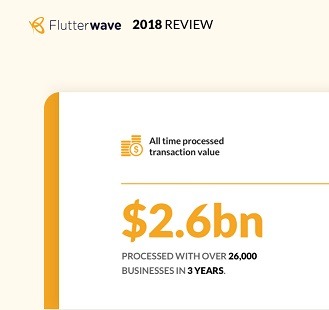
One of the co-founders, 28-year-old Nigerian entrepreneur, Iyinoluwa Aboyeji, who also co-founded Andela, served as the pioneer CEO. He was reported by CNN, as saying that he “wants Silicon Valley to fund a future where Africa is included”, and people and businesses connect with the global economy. As at the time Aboyeji stepped down as CEO last year, and handed over to his co-founder, Olugbenga Agboola, Flutterwave has completed its Series A Extension round of financing, and this has taken its total raised funding from inception to date to more than US$20 million. This shows investors’ confidence in the performance of the company.
In their 2018 review, Flutterwave announced that they saw a 550% growth in the customer base of Flutterwave for Business (Rave), which is now 26,000 strong. This was made possible by partnerships with existing customers, retaining their key partnerships within the financial industry, enterprise customers like Uber, Arik Air, Booking.com and Flywire, and as they welcomed new customers like DusuPay (Uganda), BroadPay (Zambia) and PennySmart (Ghana). The revamped Barter (Flutterwave for Customers) now boasts of over 30,000 customers.
Their terrific run of achievements in 2018 culminated in the Best Payments Company award at the Ghana eCommerce Awards ceremony.
Payment Solutions
What makes Flutterwave thick? With its payment technology solution, consumers can pay for things in their local currency, while the company takes care of integrating banks and payment-service providers into its platform and this relieves businesses of the expense and burden.
The company’s award-winning payments infrastructure which is accessible via USSD, Mobile, Point of Sale and Web channels enables banks, payments companies, and businesses to do much more. The numbers from the 2018 review by the company attest to the massive adoption of these infrastructures by merchants and customers. There is no sign that the upward growth experienced by the company will abet anytime soon.

The payment solutions are listed below.
● Rave (Flutterwave for Business) – an easy way to accept any payment method from customers and make payments, around the world online or in-store. With many positive testimonies from notable local businesses in Nigeria and beyond, signing up for rave opens up businesses to more opportunities by letting them accept a range of payment methods (card, bank account, and mobile wallet payments) from customers around the world, in person in physical stores or through app/website or on social media.
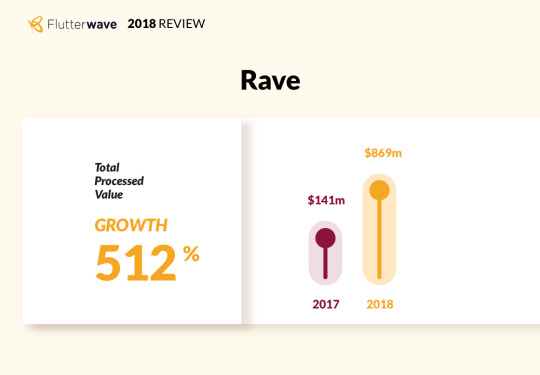
● Moneywave – used to make payments to anyone around the world. It is a payment system that allows users to securely charge cards and pays accounts. It is basically an API suite that allows connection of disparate payment sources, an omnichannel platform for payments across Africa.
● Barter (Flutterwave for Consumers) – used to issue and manage virtual and physical cards for retail, loyalty and expense management.
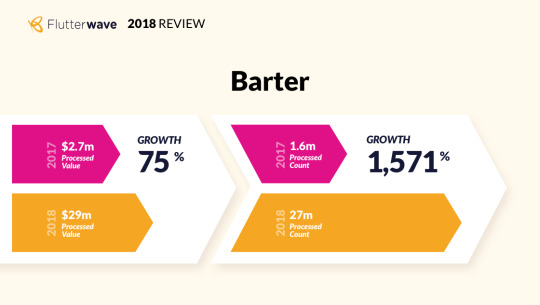
Partnerships
To accelerate its activities in its area of focus, Flutterwave has gone into various partnerships. The following partnerships are meant to address the listed issues:
1. Flywire + Flutterwave – this solution integration aims to streamline payment transactions for Nigerian students, patients, and businesses to facilitate payment of foreign school fees and medical bills in Naira.
2. Shopify + Flutterwave – this integration makes selling online easier. It helps African businesses scale globally by integrating Rave into their Shopify store.
3. Alipay + Flutterwave - this gives all Flutterwave merchants access to over 1 billion Alipay users, capturing payments activity around the estimated $200 billion in China-Africa trade. Alipay is now an additional option, to card, Barter, Mobile Money and other payment channels on the Rave checkout modal.
4. PayAttitude + Flutterwave – this only requires a customer’s phone number for a successful payment to occur, though the customer needs to be PayAttitude customer or get it first to be able to use this payment method.
5. Flutterwave + Afropolitan Group – this partnership is aimed at bridging the gap between Africa & the diaspora through entertainment & ticketing.
Developers
Flutterwave touts herself as the Google of all things Payment, with a leading community of engineers who develop the next standard of payment technology in the industry. They provide everything needed to build reliable and secure payment experiences. They make their libraries, plugins, and SDKs available so others can easily integrate and start collecting payments in minutes.
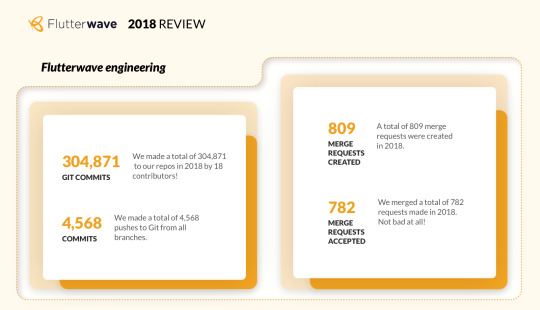
Closing Thoughts
Before this research, I knew very little about Flutterwave. In comparison to others in their space, they are heavyweights in their rights. I’m amazed at their dedication to building payments infrastructure to connect Africa to the global economy, and all that they have achieved in just a few short years. They are truly making it easier for Africans to build global businesses that can make and accept payment, anywhere from across Africa to the global economy. They have converted me and my business into customers for all their products. I am now following the relevant social media handles including that of the past and current CEOs. But more importantly, I am now their unofficial evangelist. You will be sure I will convert many into the Flutterwave way. Who knows, you the reader might just be one of them.
Image credits: Flutterwave Inc
2 notes
·
View notes
Text
New Yahoo Small business research highlights opportunities for SMB retailers to better compete against larger online rivals
Today at IRCE, Yahoo Small Business revealed findings from a recently conducted consumer survey, highlighting new opportunities for SMB retailers to meet the evolving preferences of consumers when it comes to shopping online so they can better keep up with their larger competitors. In a time when consumers can choose from a wide range of online retailers, it’s important that SMBs understand what they need to do to actively compete against larger retailers online.
The good news: a vast majority of shoppers (75 percent of those surveyed) want to shop at and support small businesses. However, 63 percent of consumers feel they get better prices and value at larger retailers. Clearly, consumers appreciate the small business experience, and smaller retailers should flex their muscles on what make them unique, but they also need to ensure they are creating opportunities to provide value in the same way as their larger competitors.
The survey findings also highlight areas for SMBs to focus on as they seek to better compete against larger retailers:
Marketing and promotion: Familiarity with retailer was the top factor influencing whether a consumer would shop small (selected by 38 percent of respondents). Regular marketing, together with promotions and discounts, helps smaller retailers not only ensure they remain top of mind for potential customers, but also that they are getting the value they demand.
Expertise in their field: Nearly one-third of consumers said they will choose a small retailer over a larger one because of their expertise in their market or their knowledge of the products that they are selling.
Human touch: Even on digital platforms, human touch is important – 38 percent of those surveyed feel large retailers lack personal touch, and 37 percent still want to speak to someone directly when shopping online.
Payment choice: More than one-third of respondents (38 percent) said it’s very important for them to have a range of payment options to choose from when shopping online.
Stay ahead of the tech curve: Outdated and inefficient websites/payment options were identified as a gripe by shoppers twice as often at smaller retailers (26 percent) versus larger ones (13 percent).
Keeping customers and their data safe: Security continues to be a top concern for shoppers, whether shopping at large or small retailers – more than one-third of respondents identified this as worry for both large and small retailers.
New Yahoo Small Business services empower SMB retailers
The message is clear: small retailers can compete with larger ones, as long as they have the tools to do so!
Yahoo Small Business is committed to helping small retailers maximize their online potential and recently launched a range of new features to its ecommerce platform, in addition to new features from its developer partners. These updates are specifically designed to make it easy for small businesses to scale their operations and deliver a customer experience more in line with what they’re used to experiencing with large internet retailers.
Key among these are:
More payment options: Seamless integration with PayPal Smart Buttons allows merchants to intelligently customize payment options for their customers. For the first time, this will introduce Venmo as a payment option on the Yahoo Small Business platform. New APIs also allow online merchants to utilize custom payments and work with additional payment processors of their choice.
Expanded subscription and promotion services: Enhanced subscription capabilities let customers schedule orders for items they regularly need, with the ability to offer discounts. Additionally, new promotion services let merchants easily offer instant and timer-based discounts, flash sales, buy-one-get-one-free promotions and more, simplifying the creation, scheduling and execution of promotions similar to large online retailers.
Improved marketing tools: A new range of customizable designs streamlines the process of building custom, branded HTML email templates for personalized communications throughout the customer journey, for everything from order confirmation and shipping status to gift certificates and sale notifications.
Navigating new tax complexities: With new legislation, the onus is now on small retailers to figure out how to collect taxes from some 15,000 different taxing jurisdictions in the U.S. This new feature helps sellers to simplify the process by integrating third party solutions for sales tax management.
Expanding reach through other leading retailers’ platforms: A web-based multi-channel order management system helps smaller retailers expand their reach and manage orders across the platforms of leading retailers – including Amazon, Lowe’s, Hayneedle, Home Depot and Walmart.
Yahoo Small Business has also introduced improved security delivered via an end-to-end SSL, advanced order exports for faster delivery of data, and additional developer tools for new ecommerce services.
With these new features, Yahoo Small Business is changing the game for small retailers and committed to helping small businesses compete with their larger competitors like never before. To learn more, please visit Yahoo Small Business.
Methodology: Survey was conducted online among 1,008 consumers in the United States, age 18 and over, between June 10-12, 2019.
1 note
·
View note
Text
Choosing The Right Ecommerce Software Development Company For Your Business
In today's digital age, establishing a strong online presence is crucial for the success of any business. Whether you are a small startup or a well-established enterprise, having a robust ecommerce platform can make all the difference. To achieve this, partnering with the right ecommerce software development company is essential. In this article, we will explore the key factors to consider when choosing the perfect development partner for your online business venture.
Expertise in Ecommerce Development:
The first and foremost factor to consider is the company's expertise in ecommerce development. They should have a proven track record of creating seamless and user-friendly online stores. Look for a company that specializes in developing custom ecommerce solutions tailored to your specific needs.
Developing API for Web Application:
In today's interconnected digital landscape, having an API (Application Programming Interface) for your web application is crucial. It enables seamless integration with various third-party services, ensuring your ecommerce platform can adapt and grow. Ensure that the chosen development company has experience in developing APIs that can facilitate easy interactions between your online store and other web services.
Shopify and Amazon Integration:
If your business aims to reach a broader audience, integrating with popular ecommerce platforms like Shopify and Amazon is essential. This allows you to tap into a vast customer base and streamline your operations. Make sure the development company has expertise in integrating your online store with these platforms, ensuring a smooth and efficient selling experience.
Customization and Scalability:
Your ecommerce platform should be flexible and scalable to accommodate your business's growth. Choose a development company that offers customization options and can adapt the platform to your changing needs. Scalability ensures that your online store can handle increased traffic and transactions as your business expands.
User Experience (UX) and Mobile Optimization:
A seamless and intuitive user experience is paramount for the success of your online store. The chosen development company should prioritize UX design, ensuring that your website is easy to navigate and visually appealing. Additionally, mobile optimization is crucial, as a significant portion of online shopping occurs on mobile devices.
Security and Compliance:
Ecommerce transactions involve sensitive customer data, making security a top priority. Ensure that the development company follows best practices for online security and compliance with industry standards, such as PCI DSS (Payment Card Industry Data Security Standard). Protecting your customers' information is essential for building trust and credibility.
Support and Maintenance:
Once your ecommerce platform is live, ongoing support and maintenance are crucial. Ensure that the development company offers reliable post-launch support to address any issues, update the software, and provide assistance as your business evolves.
In conclusion, choosing the right ecommerce software development company is a critical decision for the success of your online business. Consider their expertise, API development capabilities, integration with platforms like Shopify and Amazon, customization options, focus on user experience, security measures, and ongoing support. With the right partner, your ecommerce venture can thrive in the competitive online market.
#app development#custom development#it software solutions#software development#web development#website maintenance
1 note
·
View note
Text
What is the Amazon Seller Central API? Can I access it?
As the world's largest online retailer, Amazon provides a platform for millions of sellers to reach customers around the world. To help sellers manage their accounts and listings, Amazon offers a suite of APIs, including the Amazon Seller Central API and the newer Amazon Selling Partner API (SP API). In this blog, we'll take a closer look at these APIs and how you can access them.
What is the Amazon Seller Central API?
The Amazon Seller Central API is a legacy set of APIs that allows sellers to access and manage their Amazon seller accounts programmatically. With the Amazon Seller Central API, sellers can perform a range of tasks, such as managing orders, inventory, and listings, retrieving reports, and more.
To use the Amazon Seller Central API, sellers need to be registered on Amazon and have a Professional Selling Plan. They also need to apply for access to the API through the Amazon Developer Services portal and follow Amazon's guidelines and requirements for using the API.

What is the Amazon Selling Partner API?
The Amazon Selling Partner API (SP API) is a more recent set of APIs that provide access to Amazon selling data, functionality, and tools. The SP API is designed to replace the Amazon Marketplace Web Service (MWS) and offers several advantages over the legacy API, including a more modern architecture, improved performance, and expanded functionality.
The Amazon Selling Partner API includes a range of modules, such as Orders, Reports, Fulfillment, and Catalog Items. These modules allow sellers to manage their orders, inventory,and listings, retrieve reports, and more, all through a single, unified API.
Continue Reading...
0 notes